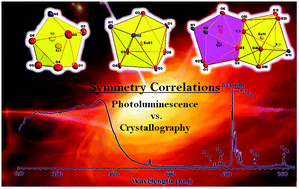Symmetry correlations between crystallographic and photoluminescence study of ternary β-diketone europium(iii) based complexes using 1,10-phenanthroline as the ancillary ligand†
Abstract
This work entails deep red emitting EuIII based complexes with a variety of ternary β-diketonate ligands and 1,10-phenanthroline as the ancillary ligand in the system. The solid state structure and spectroscopic analysis has been outlaid in terms of photoluminescence and crystallography. A luminescence quantum efficiency of 50% was obtained for the [tris-(4,4,4-trifluoro-1-chlorophenyl-butanedione)mono-(1,10-phenanthroline)europium(III)] complexes. Moreover, complexes [tris-(2,2,6,6-tetramethyl-heptanedione)mono-(1,10-phenanthroline) europium(III)] and {[hexa-(benzyl carboxylic acid) bis-(1,10-phenanthroline)di-europium(III)]-μ-[κ2-O,O′-(benzyl carboxylic acid)]2} were found to also have quantum yields of 9% and 28% with respective sensitization efficiencies of 85%, 15% and 58%. These results were articulated with crystallographic details pertaining to the nature of coordination and the effect of steric and electronic properties thereof which somewhat impacts the Eu–N bond distances. A symmetry correlation was drawn between the crystallographic data and the photoluminescence data.



 Please wait while we load your content...
Please wait while we load your content...